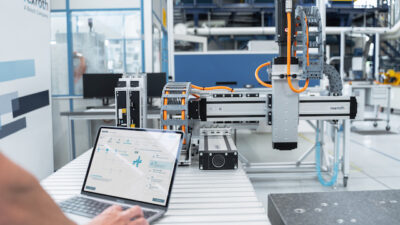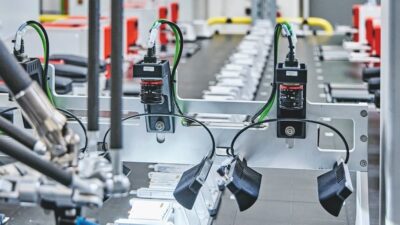Stakes in the evolving machine-to-machine (M2M) era are enormous. Some analysts estimate that nearly 50 billion devices around the world can benefit from M2M communications. That figure is nearly 10 times Earth's population. These figures, according to ABI Research (www.abiresearch.com), are attracting intense interest as businesses and equipment manufacturers begin to understand the multi-bill...
|
Stakes in the evolving machine-to-machine (M2M) era are enormous. Some analysts estimate that nearly 50 billion devices around the world can benefit from M2M communications. That figure is nearly 10 times Earth’s population.
These figures, according to ABI Research ( www.abiresearch.com ), are attracting intense interest as businesses and equipment manufacturers begin to understand the multi-billion dollar potential they represent. It is predicted that through 2009, the M2M market will increase a staggering 40% annually. Interestingly, it is expected that only 5% of networked devices will be computers by 2010. Given the scale and scope of opportunities, companies are beginning to position themselves for wide-scale adoption of M2M technologies.
M2M is also leading to significant opportunities for technology companies. By network-enabling their products, equipment makers can now offer unprecedented levels of customer service and support at a fraction of the cost required for non-networked devices. With the ability to maintain a continuous tap into a device’s data stream, companies can now track and service a device through its lifecycle.
This technology is redefining the scope of customer relationships and business operations, because companies can ensure better and more appropriate service to customers by anticipating and responding to problems as or before they arise. Some companies have discovered new revenue-generating opportunities by connecting to their devices. M2M has the potential to unleash productivity gains and economic growth unlike any previous technology wave.
Companies are looking beyond the opportunities that will arise from new product sales, aiming to capitalize on the benefits of being able to better shape customer relationships. By tracking a device through its lifetime, a company can acquire significant data and insight into product performance in different scenarios and stages, customer needs, and customer behaviors. This information can yield optimized technologies and services for customers, significant profit gains for companies involved, and improved relationships between companies and customers.
Synergy from combining M2M technology with device networking adds an unprecedented level of intelligence to business, helping to reduce maintenance costs and open opportunities for additional revenue streams.
With a typical equipment service call, for example, a customer has the repair call, which is taken by a call center, logged into a database, sent to the service center, and a technician is deployed—hopefully with the correct parts and equipment. With M2M device server technology:
-
Companies can be alerted to equipment failures before they happen, saving time and money with proactive maintenance. An electronic device (such as a security system, commercial refrigeration unit, or medical diagnostic equipment) can have technology to perform self-diagnosis and self-healing.
-
Service technicians in a central location can determine status and operating conditions of equipment located anywhere.
-
Unnecessary service calls can be eliminated. Enabled with device networking technology, equipment can connect to a network, monitor itself, and ensure that it’s functioning properly. Often, when something is wrong, a simple setting or switch adjustment is all that is required. When something irregular is noted, it frequently can be diagnosed and repaired over the network, avoiding an on-site trip.
-
When service technicians leave the service center they know exactly what needs to be repaired and have the necessary equipment and parts.
-
Organizations can increase customer satisfaction and generate an additional revenue stream through up-sale marketing offering remotely managed, value-added field services.
Large and small companies in various business sectors are using device networking to achieve their objectives.
Industrial automation
Productivity improvements, inventory management, and quality control are common challenges faced by most manufacturing facilities. From automotive to warehouse environments, the need to attach essential devices (new or legacy), is common, including PLCs, CNC/DNC equipment, process and quality control equipment, pump controllers, bar-code operator displays, scales and weighing stations, printers, machine-vision systems and other types of equipment. Networking’s penetration of industrial automation (and automation into Ethernet) will benefit automation applications. Unfortunately, serial devices used in today’s plants and buildings communicate using myriad protocols. A limiting factor is the absence of a 100% reliable way to mix multiple protocols [from different organizations] on one physical wire. Differences in packet framing, timing, and the treatment of character sequences require most protocols to operate on dedicated wires, creating challenges to multi-vendor systems, and even successive generations of products from one vendor.
| Machine-to-machine (M2M) communications through device networking technology adds intelligence and value-added services, allowing remote access, monitoring, and managing of devices via a network or Internet. Problems can be automatically detected, and often remotely diagnosed and repaired. When a service call is required, the technician knows exactly what is wrong and can travel with the proper equipment and parts. |
Device networking enables manufacturers to achieve greater efficiency and productivity on the factory floor by providing centralized access and control for all types of industrial automation equipment. With device networking, a master or slave device can be polled using the specific non-networked industrial protocol tunneled through networked TCP/IP connections via a network or over the Internet from anywhere, any time [with appropriate security].
A power meter or controller can be queried by Modbus/TCP, Profibus under IP, FOUNDATION fieldbus under IP (HSE), ControlNet/DeviceNet under IP (CIP), and many other protocols. Multiprotocol slaves/servers no longer have to fully implement each protocol, only the portions required to read and write real-time data.
A facility control center operated process-control equipment on a legacy network independent of the LAN. To network-enable all process control equipment at the support center would have required more than 1,500 ft of wiring and conduit spanning multiple buildings, a costly and time-intensive project. Instead, wired and wireless device servers have been integrated to Ethernet-enable all equipment in the support center, for significant time-savings—more than 500 PCs in the support center have access to real-time information as the process control equipment generates it. This also eliminates technicians patrolling the floor and monitoring each device individually, and speeds response times if a failure occurs.
Healthcare/medical settings
Many tasks can be performed remotely with network-enabled equipment.
A health care company develops, manufactures, and markets blood gas analyzers, which quickly and conveniently offer laboratory-quality results on blood gases, metabolites, electrolytes, and hemoglobin. In a hospital, where the amount of time to test blood can determine treatment, most testing is performed in a central lab. To improve turnaround time, hospitals are moving towards testing blood in the critical care area, but the central lab still needs to track the testing process and results. Network-enabled equipment lets hospital staff perform blood analysis at the point of care and allows the central lab to review and control results.
| Author Information |
| Shaye Shayegani, is senior field applications engineer with Lantronix, |



